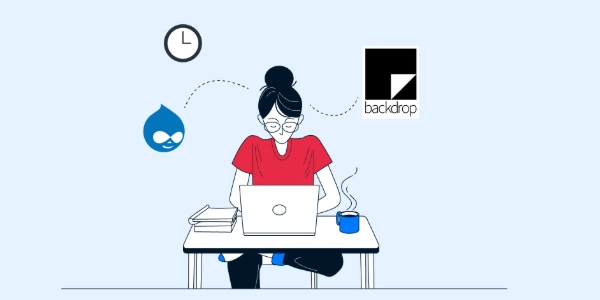How Can I migrate from Drupal 7 to Backdrop CMS?
Drupal 7’s end-of-life (Jan 2025) has left many site owners looking for alternatives. One great option is Backdrop CMS, a Drupal 7 fork designed for small to mid-sized websites. It keeps Drupal 7’s best features while improving performance and ease of use. If you’re considering migrating from Drupal 7 to Backdrop CMS, here’s a step-by-step guide to ensure a smooth transition. Why Choose Backdrop CMS? Same Familiar Structure: Built on Drupal 7’s architecture. Lightweight & Faster: Improved performance with a smaller footprint. Lower Maintenance Costs: No complex updates like Drupal 9/10. Step 1: Backup Your Drupal 7 Site Before migrating, make sure to backup your database, files, and themes to avoid data loss. Step 2: Set Up a Backdrop CMS Environment Download and install Backdrop CMS on a staging server. Ensure PHP 7.3+ is installed. Set up a new database. *Step 3: Migrate Data from Drupal 7 * Backdrop CMS has a built-in upgrade path: Place your Drupal 7 database in your Backdrop site directory. Modify settings.php to use the Drupal 7 database. Run the Backdrop upgrade script (upgrade.php). The system will migrate nodes, users, taxonomy, and menu items automatically. Step 4: Rebuild Your Site Backdrop CMS has a Layout system instead of Drupal 7’s block system, so you may need to: Reconfigure Views (Backdrop has Views built-in). Adjust Custom Modules (Some D7 modules are now part of the Backdrop core). Test Content & Permissions to ensure everything works as expected. ** Step 5: Test & Go Live** Check for missing features. Enable caching for better performance. Once satisfied, switch your DNS settings and make your Backdrop site live. Final Thoughts Backdrop CMS is an excellent choice if you want a Drupal 7-like experience without complex migrations. It’s a cost-effective, long-term solution for small businesses, nonprofits, and organizations that don’t want to rebuild their sites entirely on Drupal 9/10.

Drupal 7’s end-of-life (Jan 2025) has left many site owners looking for alternatives. One great option is Backdrop CMS, a Drupal 7 fork designed for small to mid-sized websites. It keeps Drupal 7’s best features while improving performance and ease of use.
If you’re considering migrating from Drupal 7 to Backdrop CMS, here’s a step-by-step guide to ensure a smooth transition.
Why Choose Backdrop CMS?
- Same Familiar Structure: Built on Drupal 7’s architecture.
- Lightweight & Faster: Improved performance with a smaller footprint.
- Lower Maintenance Costs: No complex updates like Drupal 9/10.
Step 1: Backup Your Drupal 7 Site
Before migrating, make sure to backup your database, files, and themes to avoid data loss.
Step 2: Set Up a Backdrop CMS Environment
- Download and install Backdrop CMS on a staging server.
- Ensure PHP 7.3+ is installed.
- Set up a new database.
*Step 3: Migrate Data from Drupal 7
*
- Backdrop CMS has a built-in upgrade path:
- Place your Drupal 7 database in your Backdrop site directory.
- Modify settings.php to use the Drupal 7 database.
- Run the Backdrop upgrade script (upgrade.php).
- The system will migrate nodes, users, taxonomy, and menu items automatically.
Step 4: Rebuild Your Site
- Backdrop CMS has a Layout system instead of Drupal 7’s block system, so you may need to:
- Reconfigure Views (Backdrop has Views built-in).
- Adjust Custom Modules (Some D7 modules are now part of the Backdrop core).
Test Content & Permissions to ensure everything works as expected.
**
Step 5: Test & Go Live**Check for missing features.
Enable caching for better performance.
Once satisfied, switch your DNS settings and make your Backdrop site live.
Final Thoughts
Backdrop CMS is an excellent choice if you want a Drupal 7-like experience without complex migrations. It’s a cost-effective, long-term solution for small businesses, nonprofits, and organizations that don’t want to rebuild their sites entirely on Drupal 9/10.




















































%20Abstract%20Background%20112024%20SOURCE%20Amazon.jpg)






















































































































![[The AI Show Episode 142]: ChatGPT’s New Image Generator, Studio Ghibli Craze and Backlash, Gemini 2.5, OpenAI Academy, 4o Updates, Vibe Marketing & xAI Acquires X](https://www.marketingaiinstitute.com/hubfs/ep%20142%20cover.png)
























































































































































































































































-Nintendo-Switch-2-–-Overview-trailer-00-00-10.png?width=1920&height=1920&fit=bounds&quality=80&format=jpg&auto=webp#)





















_Anna_Berkut_Alamy.jpg?#)













































































































![YouTube Announces New Creation Tools for Shorts [Video]](https://www.iclarified.com/images/news/96923/96923/96923-640.jpg)





































































![[Weekly funding roundup March 29-April 4] Steady-state VC inflow pre-empts Trump tariff impact](https://images.yourstory.com/cs/2/220356402d6d11e9aa979329348d4c3e/WeeklyFundingRoundupNewLogo1-1739546168054.jpg)





























































